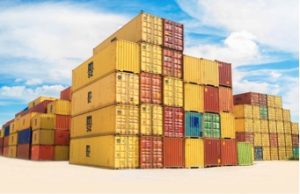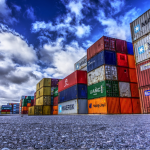Exporting by Ship? How to Choose the Right Shipping Containers
This is a guest post by Shawn Mack.

Shipping Containers Picture: https://unsplash.com/photos/tjX_sniNzgQ
While the idea of shipping goods is quite an old one, using containers for their transportation in bulk quantities across the sea is fairly new. Only about six decades ago, an entrepreneur named Malcolm McLean introduced this new, convenient method of shipping. He came up with the idea not out of mere creativity but necessity. He became so exhausted from the laborious methods of handling export goods that he had no choice.
Without a doubt, his ingenious plan was an immediate success. Today, about 60 percent of the international maritime trade occurs through container shipping. This is chiefly because most importers and exporters in the US and all around the world find it:
- Cost-effective
- Safe
- Convenient
Perhaps, the only problem with this mode of shipment is choosing the right container. With a variety available in all industries and countries, picking one container that best fits a shipper’s needs is slightly challenging.
For this very reason, we have formulated a comprehensive ship export guide for you, especially if you belong to the US. Continue reading to find out the right container for shipping your goods.
Understanding Sea Freight Types
Freight refers to bulk quantities of any goods transferred from one place to another. It can be using trucks, trains, aircraft, and ships. However, we are only discussing sea freight today, so let’s be specific.
Even in sea freight, there are various types that you might want to know about and consider when exporting.
· Full Container Load – The FCL sea freight is loading of one shipment into a 20 to 45-foot-long container.
· Less than Container Load – When different shipments get loaded into one container and transported to different consignees or even different destinations, each gets called a Less than Container Load (LCL) because each individual shipment is literally not enough to fill the shipping container on its own.
· Roll on Roll off – In RORO sea freight, vehicles loaded with cargo drive onto the ship, and then, drive off upon the arrival at the destination.
· Dry Bulk Shipping – People exporting dry commodities, such as metal, might find this one useful. In it, bulk dry commodities get poured into the hold of the ship rather than in shipping containers.
Container Varieties Based on Design
Since containers form an integral part of sea export, there’s a variety of containers. Each design or structure caters to a specific need. The following are some commonly used types of containers:
- Refrigerated Container:
Also known as a Reefer, a refrigerated container is most suitable for transporting perishable goods like fruits, vegetables, flowers, medicines, etc. It can control temperature ranging from -65°C to 40°C and comes with a generator for temperature adjustment purposes. Nowadays, refrigerated ISO (International Organization for Standardization) containers also come equipped with other advanced technology like cryogenic cooling or carbon dioxide cooling systems.
- Insulated Container:
Like the reefer, the insulated container protects goods from changes in temperature but without cooling system. It helps to preserve the heat of the transported goods by stabilizing the temperature, be it warm or cold. Moreover, these containers get built with materials that do not wear out after extensive exposure to hot or cold temperatures.
- Dry Van Box:
Perhaps, the most common of all is the dry van box, which is also known as a dry storage container. It comes into use when manufacturers of most non-edible items wish to transport their goods in bulk quantities.
Usually, it is made of steel or aluminum and is super strong. About eight of these containers can be stacked one over another. Plus, the most common sizes used are 40ft, 20ft, and 10ft.
- Flat Rack Container:
The flat rack container comes with collapsible sides to ship goods with unique dimensions, such as pipes, boats, and machinery. At times, these also come into use for shipping cars over short distances.
- Car carriers:
Car carriers are units that are fully equipped for transporting cars over long distances. Note that it is a covered storage unit with collapsible sides to make car loading easier. Also, they can carry more than one car per shipment. Some other types of containers based on design include:
- Drums
- Intermediate Bulk Container
- Open Top Container
- Open Side Storage Container
- Tanks
- Tunnel Container
Finding the Right Shipping Container Size
Apart from the above types, there is one more factor to consider: the size of the container. The size of a shipping container holds immense importance as the wrong size can damage the goods’ quality.
Well, back in time, the very first containers that came into existence were only 33-35 feet long. Hence, the limited option in size restricted the exporters to transport certain goods. You see, the container wasn’t also compatible with different freight types.
In 1961, the International Organization for Standardization solved the problem by introducing three standard sizes. Ever since, these sizes get used in all types of freight. The sizes are:
- 20-ft Container – Its design enables it to carry heavyweight goods, such as minerals and machinery. The 20ft Container also gets called a Twenty-foot Equivalent Unit (TEU).
- 40-ft Container – Moreso than the 20-ft, 40-ft containers are meant to transport voluminous goods rather than heavy. This container gets referred to as 2TEU or FEU.
- 40-ft High Cube Container – It’s similar to the 40ft one, though it has an additional foot in height.
Final Thoughts
Conclusively, choosing the right shipping containers holds great significance when exporting. Of course, with the interdependent system of trade, the selection will not completely guarantee safety. However, it will promise safety to a certain extent and give you confidence.
The two prominent factors that help in selection include the type and size. With knowledge, choosing the right container becomes quite easy. Hopefully, the details above regarding the selection are comprehensive. Good luck!
This was a guest post by Shawn Mack.
Author Bio




